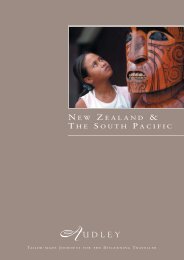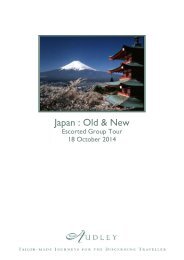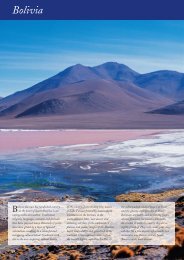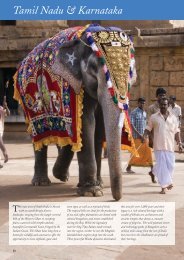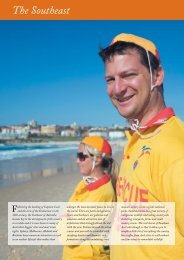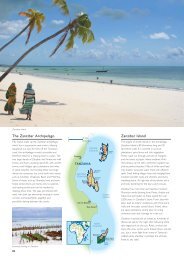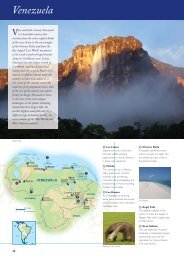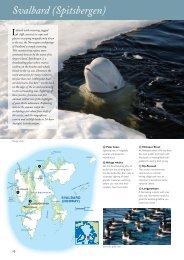Download - Audley Travel
Download - Audley Travel
Download - Audley Travel
You also want an ePaper? Increase the reach of your titles
YUMPU automatically turns print PDFs into web optimized ePapers that Google loves.
Festivals<br />
Taiko drummers performing at a local festival<br />
Japan has an abundance of local festivals,<br />
known as matsuri, connected with shrines and<br />
temples throughout the country. Most are<br />
held annually on a particular set date or<br />
within a few days of this. They celebrate or<br />
commemorate a number of things, from<br />
seasonality or historic events to ancient<br />
legends and deities. Festivals are sociable and<br />
community-based events and more often<br />
than not are colourful, raucous and joyous.<br />
Mikoshi being paraded at Sanja Matsuri<br />
These lively affairs often involve a procession,<br />
whose participants carry a mikoshi – a special,<br />
decorated shrine containing the spirit of the<br />
local Shinto kami (gods) – through the streets.<br />
Many festivals also involve large, decorated<br />
floats, music and traditional dances.<br />
As the festivals are popular with domestic<br />
tourists, accommodation during some of<br />
the larger ones can be difficult to secure<br />
at late notice.<br />
Key festivals<br />
Yuki Matsuri (early February)<br />
Held every February in Sapporo, the capital<br />
city of Hokkaido, this week-long snow<br />
festival sees huge ice sculptures created<br />
along the Odori-koen park, ranging from near<br />
life-size imitations of feudal castles to kitsch<br />
replicas of cartoon favourites. The event is<br />
illuminated at night and is a spectacular sight<br />
from the TV tower at the end of the park’s<br />
main thoroughfare.<br />
Sanja Matsuri (16-21 May)<br />
The Sanja matsuri of Asakusa Shrine is one<br />
of the three biggest festivals in Tokyo, along<br />
with the Kanda Festival and Sanno Festival.<br />
It became very popular during the Edo<br />
period (1603-1868), and today involves the<br />
parading by residents of more than a hundred<br />
mikoshi around the crowded streets near<br />
Asakusa Shrine.<br />
Nebuta Matsuri, Aomori<br />
Nebuta Matsuri (early August)<br />
The Nebuta Matsuri is held in Aomori and<br />
attracts more than three million visitors each<br />
year. Legend has it that in the 9th century AD,<br />
General Tamuramaro subjugated his enemies’<br />
armies by frightening them with huge lanterns,<br />
replicas of which are now carried through the<br />
streets on festival evenings. This is definitely a<br />
festival to find yourself caught up in and<br />
carried away by.<br />
Jidai Matsuri (22 October)<br />
Kyoto’s Jidai Matsuri (Festival of the Ages)<br />
dates back to 1895, and takes place to<br />
commemorate Kyoto becoming the capital of<br />
Japan in 794 AD. The focal point is the Jidai<br />
Gyoretsu procession, which features a parade<br />
of splendid traditional costumes. At the front,<br />
participants wear the local dress of 1868<br />
(the year that the capital was transferred to<br />
Tokyo) with the costumes behind going<br />
progressively back in time until the Heian<br />
period (6th Century AD).<br />
26



